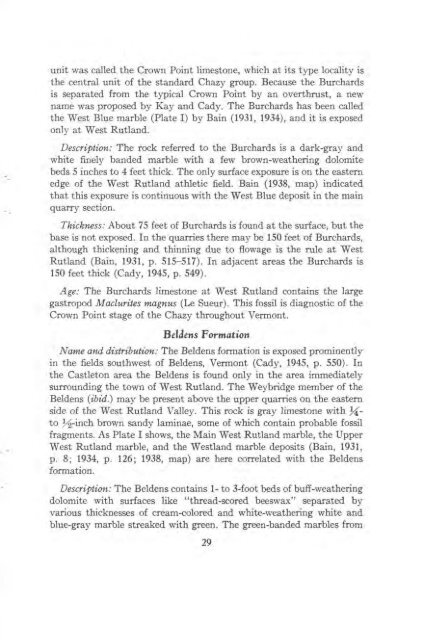STRATIGRAPHY AND STRUCTURE CASTLETON AREA VERMONT
STRATIGRAPHY AND STRUCTURE CASTLETON AREA VERMONT
STRATIGRAPHY AND STRUCTURE CASTLETON AREA VERMONT
You also want an ePaper? Increase the reach of your titles
YUMPU automatically turns print PDFs into web optimized ePapers that Google loves.
unit was called the Crown Point limestone, which at its type locality is<br />
the central unit of the standard Chazy group. Because the Burchards<br />
is separated from the typical Crown Point by an overthrust, a new<br />
name was proposed by Kay and Cady. The Burchards has been called<br />
the West Blue marble (Plate I) by Bain (1931, 1934), and it is exposed<br />
only at West Rutland.<br />
Description: The rock referred to the Burchards is a dark-gray and<br />
white finely banded marble with a few brown-weathering dolomite<br />
beds 5 inches to 4 feet thick. The only surface exposure is on the eastern<br />
edge of the West Rutland athletic field. Bain (1938, map) indicated<br />
that this exposure is continuous with the West Blue deposit in the main<br />
quarry section.<br />
Thickness: About 75 feet of Burchards is found at the surface, but the<br />
base is not exposed. In the quarries there may be 150 feet of Burchards,<br />
although thickening and thinning due to fiowage is the rule at West<br />
Rutland (Bain, 1931, p. 515-517). In adjacent areas the Burchards is<br />
150 feet thick (Cady, 1945, p. 549).<br />
Age: The Burchards limestone at West Rutland contains the large<br />
gastropod Maci urites magnus (Le Sueur). This fossil is diagnostic of the<br />
Crown Point stage of the Chazy throughout Vermont.<br />
Beldens Formation<br />
Name and distribution: The Beldens formation is exposed prominently<br />
in the fields southwest of Beldens, Vermont (Cady, 1945, p. 550). In<br />
the Castleton area the Beldens is found only in the area immediately<br />
surrounding the town of West Rutland. The Weybridge member of the<br />
Beldens (ibid.) may be present above the upper quarries on the eastern<br />
side of the West Rutland Valley. This rock is gray limestone with 3.-<br />
to 3/2-inch brown sandy laminae, some of which contain probable fossil<br />
fragments. As Plate I shows, the Main West Rutland marble, the Upper<br />
West Rutland marble, and the Westland marble deposits (Bain, 1931,<br />
p. 8; 1934, p. 126; 1938, map) are here correlated with the Beldens<br />
formation.<br />
Description: The Beldens contains 1- to 3-foot beds of buff-weathering<br />
dolomite with surfaces like "thread-scored beeswax" separated by<br />
various thicknesses of cream-colored and white-weathering white and<br />
blue-gray marble streaked with green. The green-banded marbles from<br />
29













